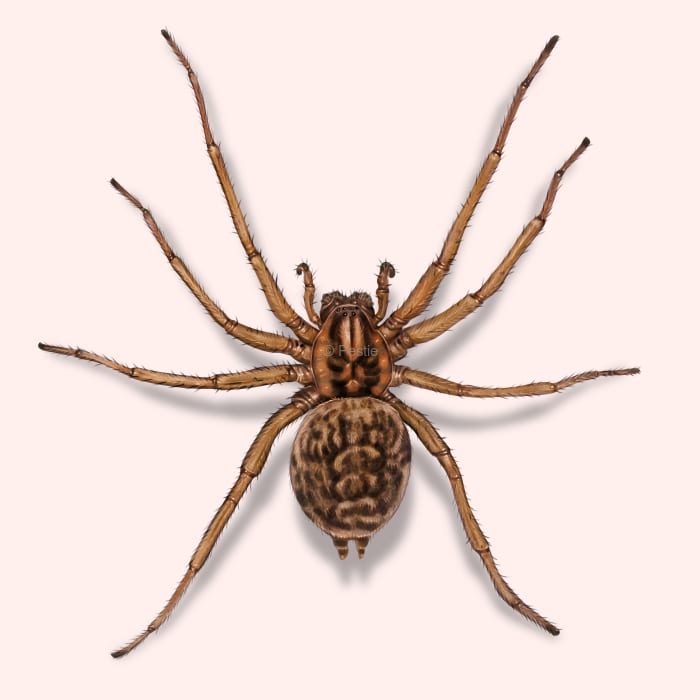How to identify and get rid of hobo spiders

The misunderstood vagabond: facts about the hobo spider
We humans have a wonderful way of assuming the worst about new and creepy-looking critters, and then sharing those scary “facts” with everyone interested.
That seems to be the case with the hobo spider, a funnel-web spider that somehow made its way from Europe and into the northwestern part of the US.
Hobo spiders have been deemed extremely dangerous by worried homeowners and anxious parents, as they claim that the bite of the hobo spider can rot your flesh. Their sneaky hideouts in bed sheets and clothes on the floor can also cause concern.
Fortunately, hobo spiders aren’t as threatening as most people make them out to be.
How to identify hobo spiders
Hobo spiders can often vary in their markings and appearance, and identifying them based on colors alone can be very difficult. They look very similar to other funnel web spiders, and for accurate identification, an expert will need to look at anatomic structures to determine the species.
Their bodies are only about ½ inch long and with their legs, they can be 1 to 1 ¾ inches in length.
Some things to look out for are the lack of dark banding on the spider’s legs and the V-shaped markings that are on the abdomen.
Additionally, they won’t have dark stripes running down the body segment nearest their head, also known as the cephalothorax.
How big are hobo spiders?
Hobo spiders are about the size of a quarter with their legs spread out.
What other spiders look like a hobo spider?
Many different spiders get confused for hobo spiders, especially other funnel web spiders. They can be hard to tell apart, and only by looking through a microscope can you guarantee an accurate identification.
Other spiders that might look like hobo spiders include grass spiders, domestic house spiders, wolf spiders, and brown recluses.
False reports of hobo spiders or brown recluses come up frequently. However, hobo spiders are isolated in the Northwestern part of the US and brown recluses are only found in the Midwest of the US.
Where do hobo spiders live?
Hobo spiders are native to Europe and were accidentally introduced into the northwestern parts of the US, including the Pacific Northwest, Montana, Wyoming, Colorado, and northern Utah. They have not established themselves in California.
Their natural habitat is in grasses, log piles, and rock piles where they build their funnel-like webs to catch prey. They are most likely to invade homes during the late summer and early fall when temperatures begin to drop.
How to get rid of hobo spiders
Hobo spiders come into the home to seek shelter and to stay warm during cooler months. It’s best to first monitor for spiders entering your home with sticky traps along the baseboards. That way, you can see if there are hotspots where spiders are coming in.
Sealing up cracks and gaps in the home, installing door sweeps, and replacing weather stripping can prevent hobo spiders and other arthropod invaders from entering your home.
Vacuuming regularly and minimizing clutter can eliminate hiding spots and potential food sources. Additionally, during the late summer and early fall, make sure to shake out bedding and clothing that have made contact with the floor for some time.
If you suspect that you’ll have potential problems with spiders, one of the best ways to prevent hobo spiders from coming into your home is by spraying and maintaining a bug-barrier. With the Pestie Smart Pest Plan, you’ll get a pro-grade, DIY solution delivered right to your door so you can enjoy a pest-free home year-round.
Treat hobo spiders with Pestie
If you're still having trouble keeping hobo spiders away, the best option is to use a pro-grade, effective pest control solution like Pestie.
Pestie is a do-it-yourself pest control solution that's specially designed to keep hobo spiders and other pests away from your home.
With Pestie, you can rest easy knowing that your living space is protected and free of creepy crawlies. And the best part? It's designed for people, pets, and the planet, so you can say goodbye to harsh chemicals and hello to peace of mind!
- Save hundreds compared to traditional annual pest plans
- People, pet, and planet-friendly
- Pro-grade customized formulas
Quick facts
- Scientific name
Eratigena agrestis
- Other common names
Funnel Web Spiders
- Colors
Brown, grey
- Life span
1-3 years
- Diet
Insects and other spiders
How dangerous are Hobo Spiders?
Low danger risk
Hobo spiders have a bad reputation for being aggressive and extremely venomous spiders, but none of those things are true! One of the problems lies within their scientific name. The name “agrestis” sounds similar to aggressive, but it’s Latin for “rural” or “in the fields”.
The truth is that hobo spiders are not aggressive at all and their mandibles are too weak to penetrate skin. They do, however, like to hide inside sheets and shirts that are left on the ground and could potentially bite if they were pressed between the sheet and skin.
And for necrotic venom that rots your flesh? Multiple scientific studies have shown that that isn’t the case. Instead, secondary infections, like MRSA, are the likely culprit for any serious infections.








